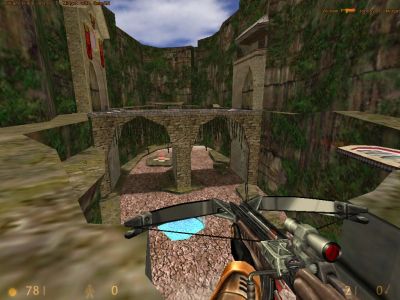These three entities are the most basic of the visible brushed based entities. To create one, in VHE, create a brush, select it and press Ctrl-T to turn it into an entity, and select the one you want. In QuArK, choose HL entities from the buttons on the left bar (should have a picture of a blue cube on it), goto Func_ entities and click on the one you want; resize and retexture the brush that comes with it however you need it.
Now, how are these used, and for what purpose?
One of the simplest reasons to use a func_wall is for its rendering capabilities. All visible brush based entities have these same capabilities, but the func_wall is basically a "no frills" usage. Under rendermode, there are a few choices: Normal, Solid, Color, Texture, Glow and Additive. Normal just renders the brush like a normal world brush. Solid will take the blue out of any of the rail textures that begin with {. Color allows you to make the brush a solid color, irregardless of the texture. Texture will take the blue out of a { texture and create a partially transparent brush, such as glass or ice. Glow isn't used for brush based entities. Additive will take the black out of a texture, blue out of a { texture, and create a partially transparent brush.
To make use of the rendermode, a rendervalue must be specified.
For Color, Texture and Additive, the value determines just how transparent it will be. 0 is completely transparent whereas 255 is completely visible. Note that light is ignored for brushes with these rendermodes so that the texture will be rendered fullbright. Thus, the value you'll need to look a certain level of transparency in a dark room will be lower than the value you need in a bright room.
For Solid, 0 means the brush will not be rendered at all. Anything larger than 0 will render the brush.
For normal, it is ignored.
Rendercolor is only used for Color rendermode. Input the color as an R G B triplet. Uses spaces and choose 0-255 for each primary color. So pure red would be 255 0 0, pure blue would be 0 0 255 and orange would be something like 255 128 0. A brown might be 150 75 0.
The difference between a func_illusionary and func_wall is simply that the func_wall will act as a barrier for players and bullets, while an illusionary lets everything pass through. Pairing an illusionary with a clip brush creates an object people cannot walk through but can shoot through.
Both the func_illusionary and the func_wall have a targetname field. Triggering them using this doesn't affect the brushes in any really noticeable way, unless they have a toggling texture applied. They also can be killtargeted and manipulated with an env_render if they are named, but typically you will not need to specify a targetname.
Func_wall_toggle acts like a func_wall but with a difference, triggering it will cause it to disappear if it is visible and appear if it is invisible. When invisible, it will not block players or bullets. It has one spawnflag, which allows it to start the game invisible instead of visible. Almost every func_wall_toggle will need a targetname.


